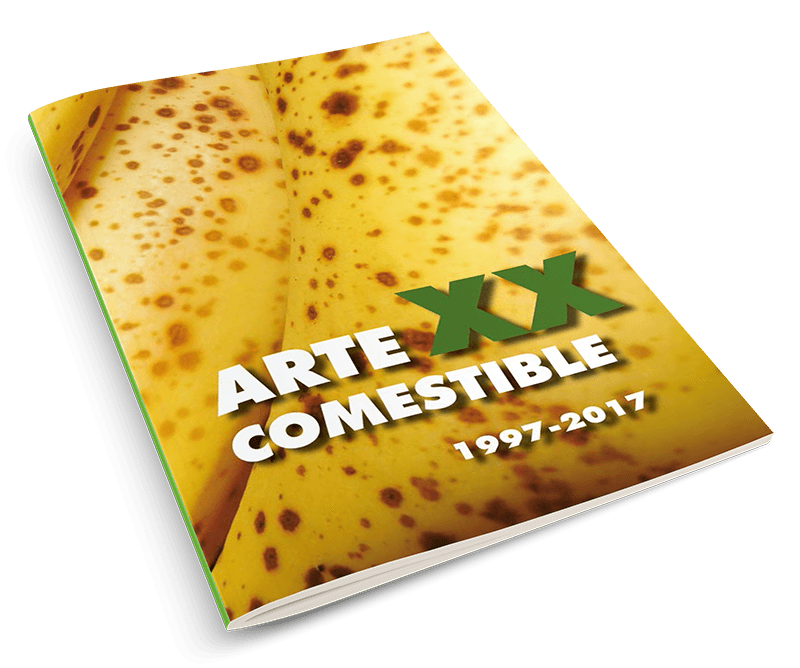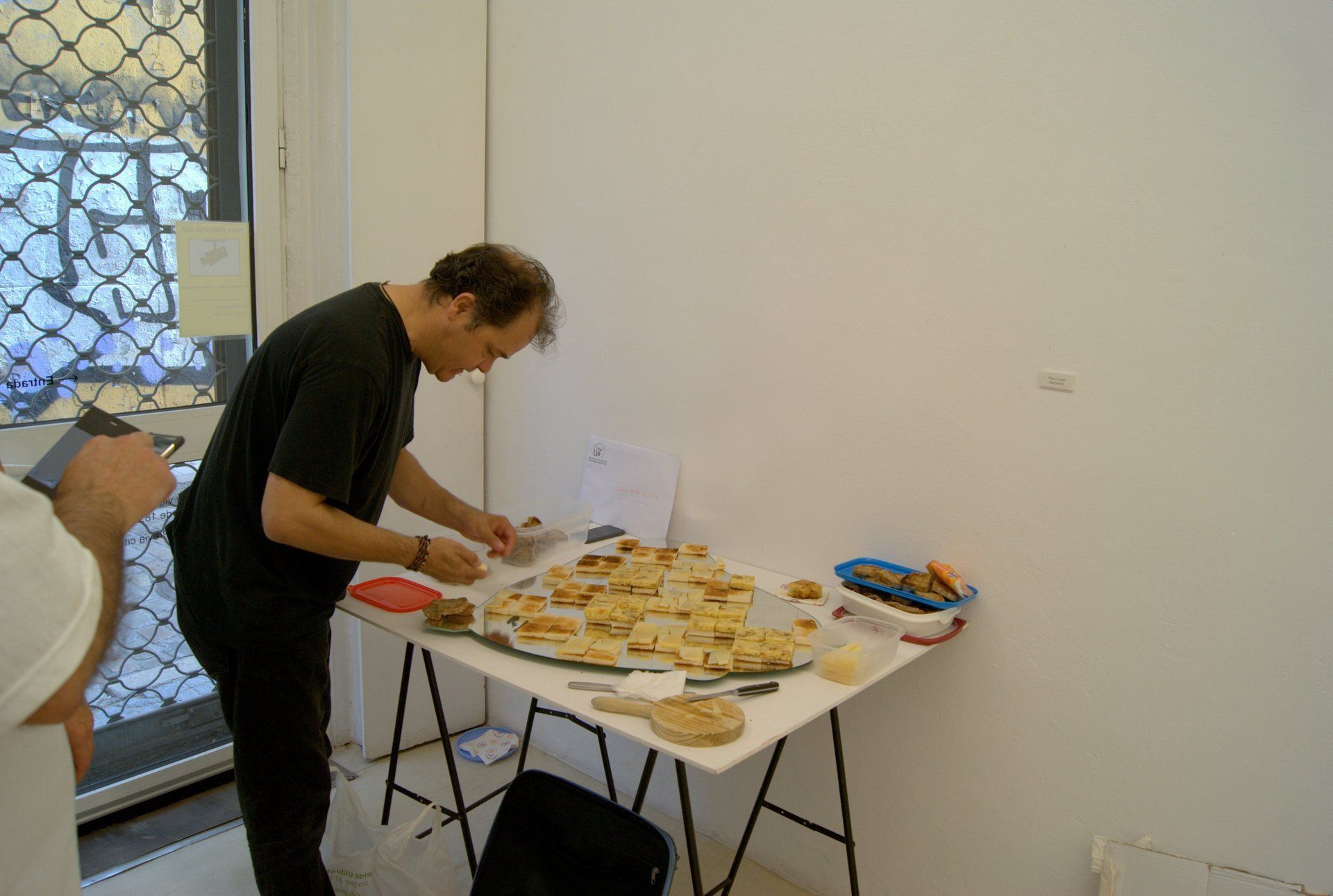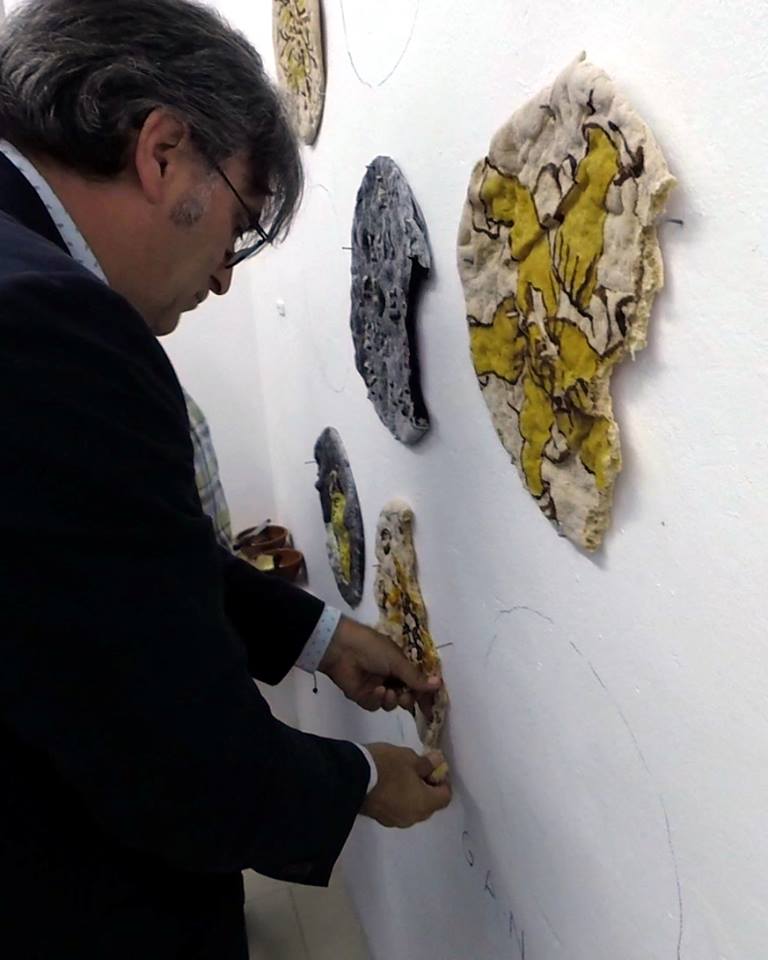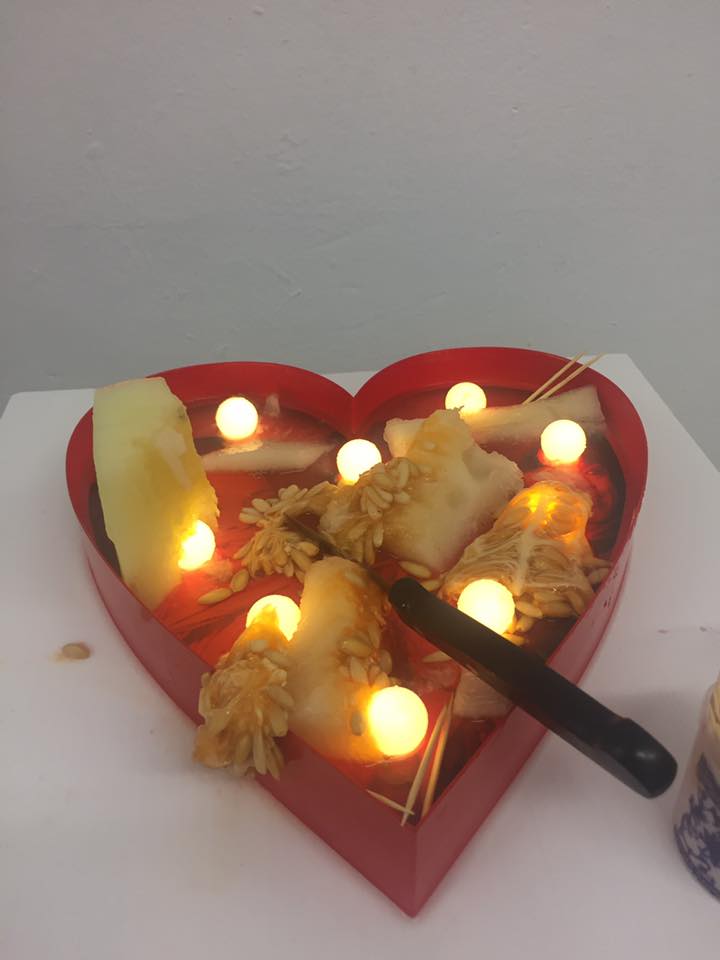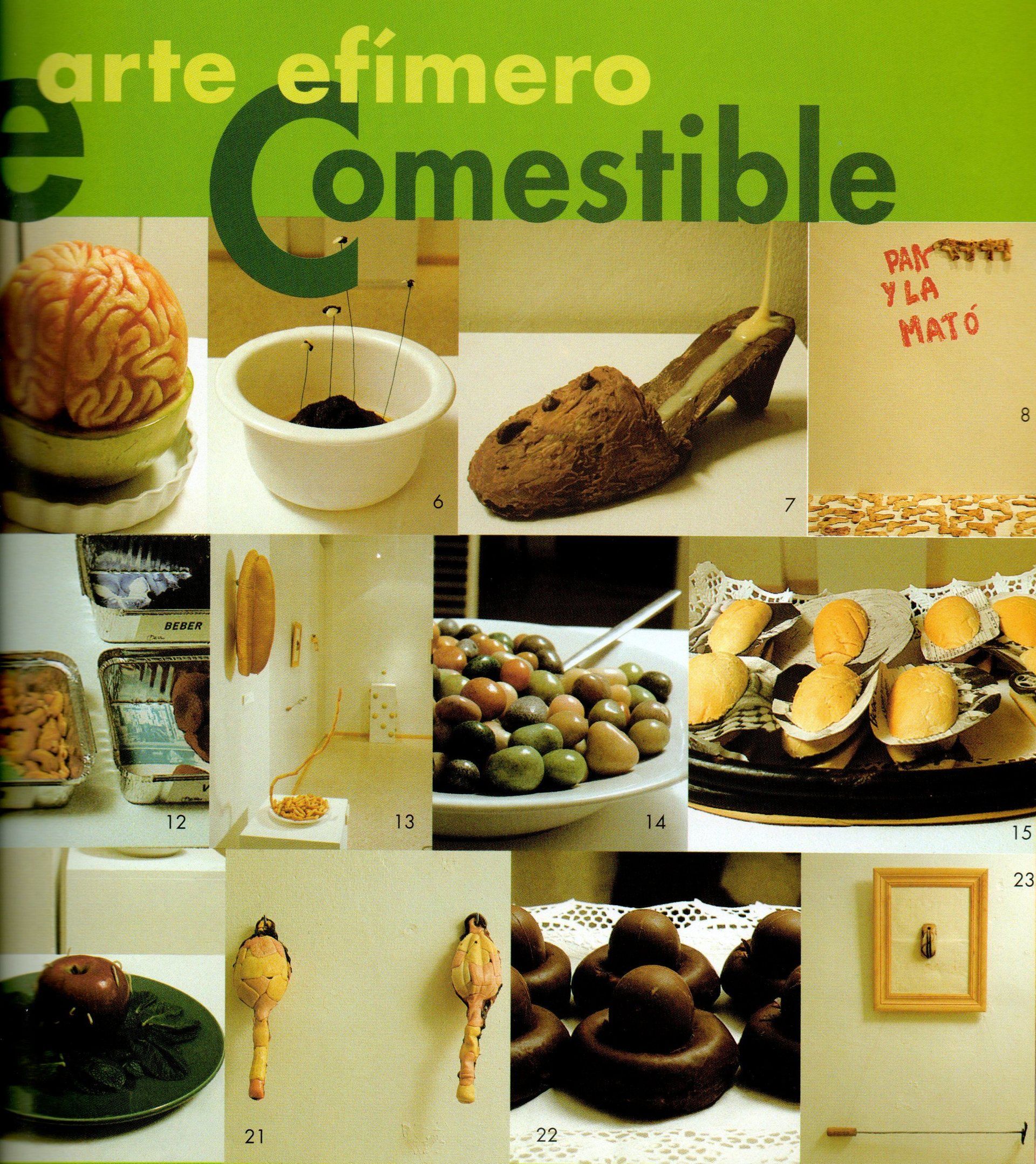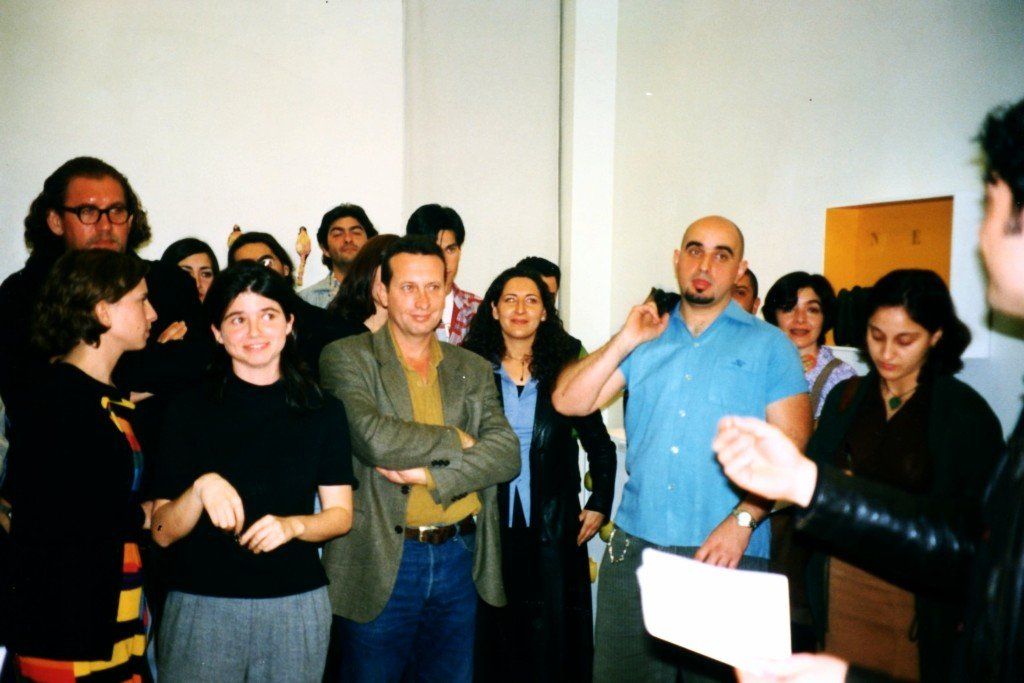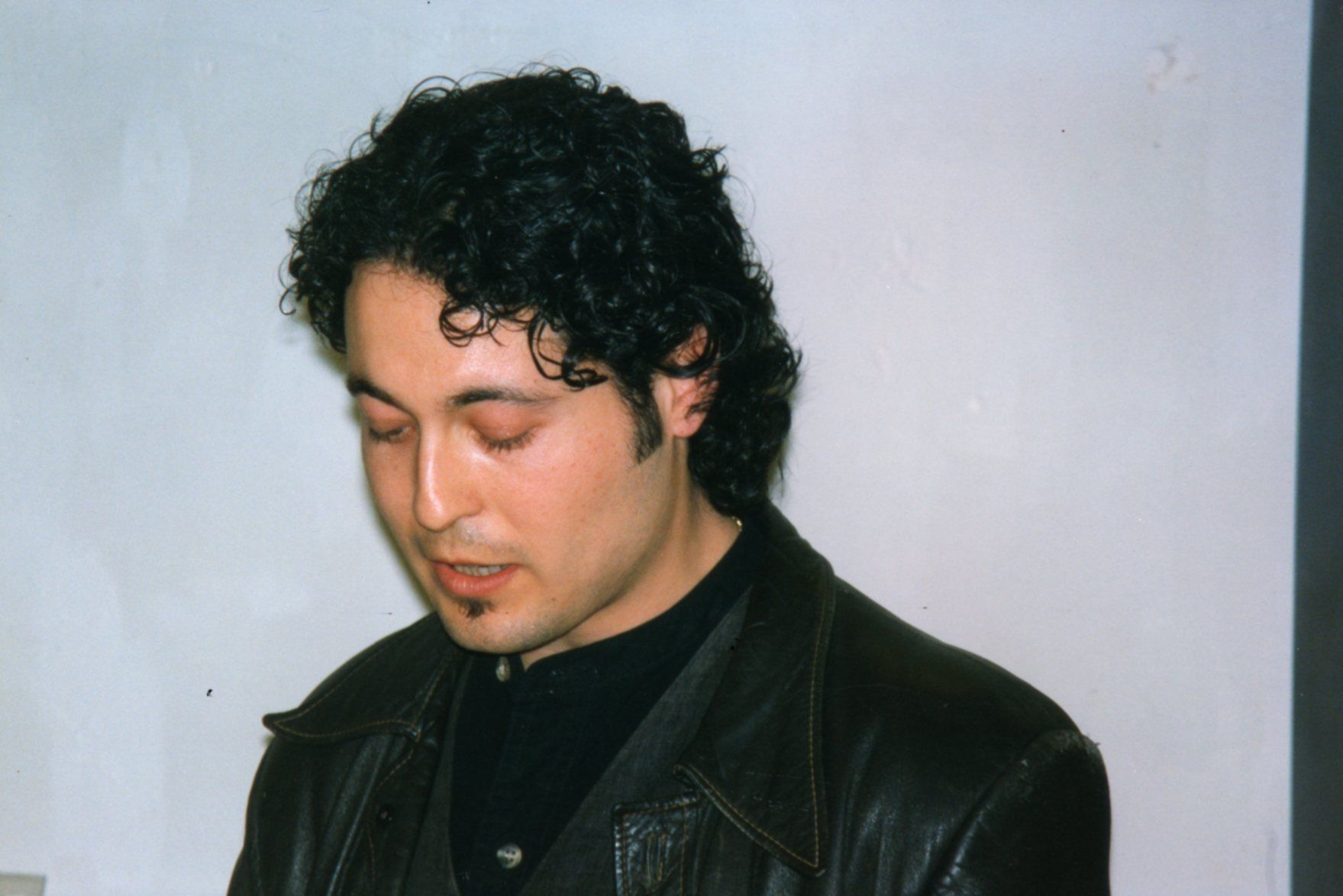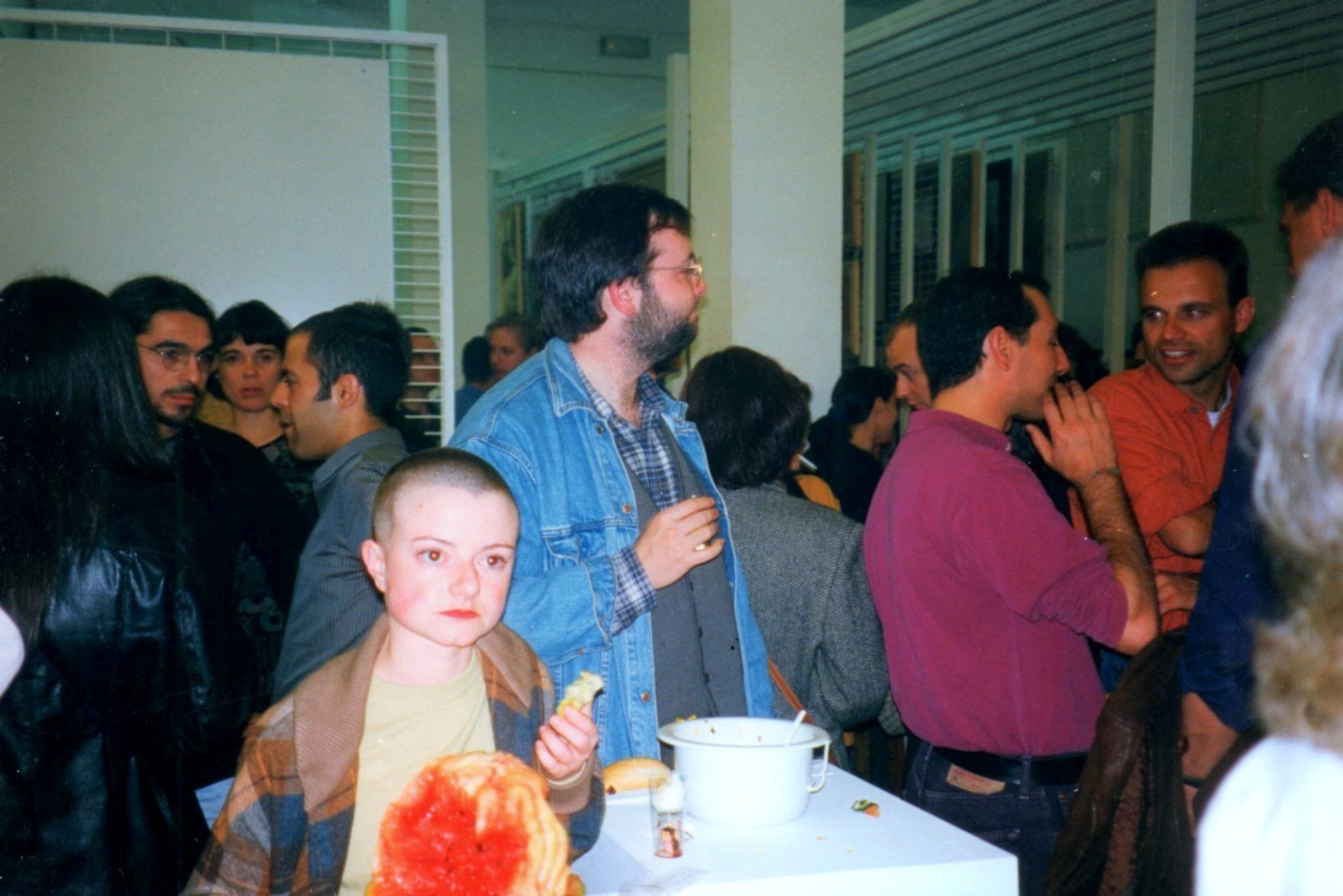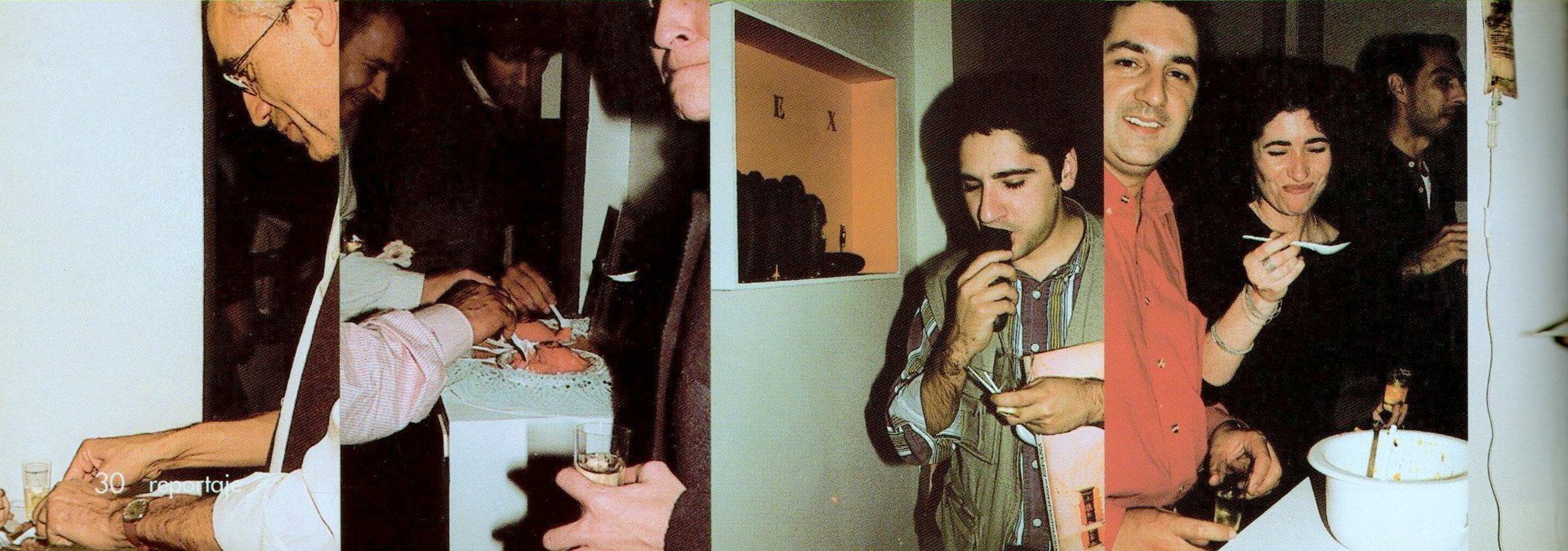EDITABLE ART (1997-2017)
In 1997, Jesús Algovi organized an action event in his studio (Acción Directa), as a gallery, to which he invited a large group of artist and intellectual friends to participate. About fifty people participated in this event, in which Algovi read the manifesto of Edible Art. With a critical and ironic character regarding the situation of the culture in general and the contemporary art market in particular. The participating artists presented works that were eaten directly at the opening ceremony itself. Being an ephemeral event, intense, fun and a wide media coverage.This act gave rise to a ritual that was repeated and extended year after year. In 1998, Algovi organized it in the Galería Arteteca. In 1999 it took place in the Diputación de Sevilla. In the year 2000 it was held at the Andalusian Center for Contemporary Art. It became a revulsive that brought together an important part of the Andalusian avant-garde of those years.
"XX YEARS OF EDIBLE ART"
TEXT CATALOG:
On Saturday, May 27, 2017 at the Weber-Lutgen Gallery in Seville we realized, after two decades, the happening that commemorates the XX Years of the first action of Edible Art, made in May of 1997 in Seville, the Action Center Art Direct . Action that we continued in 1998 in the Arteteca Gallery, in 1999 in the Central Courtyard of the Diputación de Sevilla and in 2000 in the CAAC.
The origin
Two decades ago I wrote the manifesto and recited for the occasion uploaded to a ladder, as a pulpit, starting the first EDESTIBLE ART action. Happening that we repeat and expand in the following years. We opened a new space in Seville. The Direct Action Art Center was transformed into an ephemeral gallery, in which all present works fulfilled two conditions: to be made of "edible" materials and to be devoured by the attending public-director. The inaugural act of the "exhibition" immediately became a happening, where spectators in communion with the authors were confused in a single action: the "consumption of art".
The daily asepsis of the common acts in an exhibition opening was transformed into an uninhibited enjoyment, with a sarcastic look. This transgression of the protocol provoked a conceptual duality: a primary playful sense and the critical reflection of the actual situation of contemporary art.
The curious thing about this action was the freshness, along with a high dose of young self-confidence, humor, lack of shame, acid sarcasm and an absolute ignorance about similar or previous plastic proposals. It is curious that the more one separates from the mainstream, many are those who, immediately, try to find you background - type "that has already been done" - that surprisingly do not pose in more conventional works, to protect their mistreated egos and thus avoid the patent lack of originality. It is a "sport" habitual in our country. But behind the logical question of where and when was always followed by an ignorant shrug.
A curious anecdote was the commotion created in the presentation of the round table in the fourth (although the organization ranked it as third since it omitted the first) action in the CAAC of the year 2000. After the presentation of the three speakers and especially the last speech by Fernando Martín (professor of contemporary art at the University of Seville) where edible art actions were reviewed, even mentioning some later, but without mentioning the previous calls, nor its origin or the authorship of it. This provoked the protests of an important part of the present public that had attended the previous ones and the later apologies of the speakers.
The reference
Antecedents on the presence of the food in the art exist from their more remote beginnings. The still lifes are a genre of their own with an evident protagonism of the food. Arcimboldo1 took him to the field of figuration, advancing several centuries to the surrealist postulates.
Closer in time and space are the ultraist evenings, held in Seville (1919) and Madrid (1921). The meetings of writers of the generation of 27 called "superrealistic dinners", which became a new ludus at a later time in the vanguard. The famous literary dinners led by Gómez de la Serna at the Café del Pombo. Or the "surrealist dinners" by Alejandro Collantes. All of them linked to the literary and poetic field.
In the field closest to the plastic we also have many backgrounds. Said Salvador Dalí: "The jaw is our best tool to cling to philosophical knowledge" because food and surrealism are perfect lovers: sex and lobsters, collage and cannibalism, the meeting of a swan and a toothbrush in a bakery ... opulent dinners organized by Salvador Dalí and Gala were legendary and an example of surrealist action. Dalí published a cookbook in 1973, "Les dîners de Gala" 3, which reveals some of those sensual, imaginative and exotic ingredients that converged in such famous encounters, not without some decadent character, snobbishness and a clear kitsch aesthetic.
On July 21, 1960, Piero Manzoni presented at the Azimut gallery one of his most famous performances: the consumption of the dynamic art of the public that devours art ("Consumazione dell'arte dinamica del pubblico divorare l'arte").
The artist signed with the thumbprint some hard eggs that would be consumed insitu by the public.
In the sixties the world of art of action in contemporary art came into force and was one of the strongholds of the avant-garde of that time: ZAJ (Spain) 4, Gutai (Japan) 5 and Fluxus (Germany) 6. Of this period I also highlight Daniel Spoerri7 with his famous assemblages with remains of meals as an objectual still life that they create as everyday scenes frozen in time. Or Claes Oldemburg8 with its appetizing edible-looking sculptures.
I must also mention Antoni Miralda who together with Dorothée Selz9 impellers of edible art ceremonies (Paris and London from 1962 to 1966). The "Rituels" (happenings) are a contribution of the new Catalan generation to vanduardia in Europe. Miralda was the special guest and participated with a video-installation in the third sample (Diputación de Sevilla, 1999) of edible art in Seville.
But I must point out that it is only apparent the resemblance of these "Rituels" with our edible art action. These actions of the sixties and seventies had a marked playful sense, with influences from the counterculture, the hippie movement and closer to dalinian Surrealist dinners impregnated with snobbery.
The essence
The action that I started in 1997 had a marked critical and political sense. Made by plastic artists who mostly work objectual art and are not immersed in the world of action. The works could perfectly be made of stable and durable materials and be the object of the market. That is to say: the work, the object, takes precedence, although this is finally ephemeral and devoured like Saturn to its children. Therefore, it has that primitive and ambivalent degree between anthropophagy and communion. It is a sarcastic and deep satire (in spite of its playful surface) to the lack of market and the precariousness of the work of the plastic artist dedicated to contemporary art. The creators breathe weathered and skeptical in the arduous riddle of survival. It is the tax role of sísifos that we have had to develop in the great comedy of contemporary culture. The action of swallowing one's own works becomes a metaphor in response to this situation. Destroy our works and feed the public and us with them. This action implicitly involves protest, self-criticism enveloped and sweetened by its ludic-festive character, but with the acid humor that accompanies sarcasm.
Gone are the happy eighties ", or as Brea would say:" Before and after the enthusiasm "... Many who lived that splendor are now in a haven of disappointment, others belong to the nineties, called generation" X "and in line with the cinephile sign touched us the "hard." But instead of improving and get out of that spiral that leads to the drain, we have discovered the global crisis.We are doing a dark tour visiting the interesting sewers, we know the subsoil in an uncertain descent with many siren songs with green fluorescent plastic buds, we now feed on the kandiskyano "principle of inner necessity" or the "external" Warholian, but, in turn, perseverance in work (objectual) causes a greater stock of work In studies, the paradoxical anguish of saturation appears in many cases, but Sisyphus can be happy and enjoy the views before the already familiar next fall. uz green of the next taxi that will leave you at the source in a circular way and shows you on the way the city that, like river water, never repeats itself. The road enriches you and not destiny.
Contemporary art is far from the public. It is restricted, usually to a cultured elite, which clearly hinders its social echo. The codes of creative expression have evolved at a much greater rate than the cultural base. To this we can add a retired educational system, designed by inept bureaucrats emerged from the fry of the party, with no more culture or title than its slogan. To draw a democracy without culture is to point the way to tyranny. But that is the fear of the system: art can make the threads of power visible. The less culture the greater docility. Rome already did it: bread and circus. But from the circus there may be a Hop-Frog that changes the laughs at the end of the show.
Many are those who deny the existence of radicalisms in contemporary art. But History is marked by examples that demonstrate the non-safety of art.
The average viewer has to force his mind to glimpse the keys of a new art. As Leonardo would say "Love is the son of a knowledge and that love is greater the greater that knowledge." But for this to occur is necessary a motivation, an approach. Like quantum physics, everyone knows the term even if they do not understand it. But in art there is often a frontal rejection. Prejudices that do not exist with physics. But in this action: the public approaches art, literally digests the work, enjoys, has fun, reflects, desacralizes the object. And it is that the action of eating is absolutely daily and common to every human being, where the senses of taste, smell, touch, vision and even hearing come together. People outside the current art come out of the happening with a positive and open vision. The fear of hermetic asepsis of the learned culture disappears. And it is that the contemporary plastic expression - and this action makes it patent - can be fun and close to the broad public.
The manifesto
ART is consumed. If so, let's eat it ... with great pleasure.
We carry out today an edible, consumable ART,
with-itself, with-itself, for the same
director, critic and consumer. All to one! ... To consume!
This installation is non-returnable; It is digestible and biodegradable.
Make the agape, try it, criticize it.
ENJOY ART, democratic, democratic art,
intellect-ritual.
The decision is instantaneous, reservation is impossible,
the acquisition is its purpose.
The pose no longer exists: the noses rise only to smell.
The exquisite public does not interest or not. The work is exquisite or not.
This sample-test makes a lot of sense: sense of sight,
sense of taste. OF GOOD TASTE AND BAD TASTE.
And what is more important: sense of humor.
Let's comply with the current columbine paradox:
Let's be tonight "artists Juan Palomo":
I stew it, I expose it and I eat it.
(Jesús Algovi and Manuela Bascón, Sevilla 1997.)
The history
With this manifesto that I wrote for the occasion and launched orally up a ladder, as a pulpit, began in my studio (Art Center Direct Action, in Divina Pastora Street) to the first action of COMESTIBLE ART made in Seville in May of 1997.
Among a varied audience of approximately fifty people, there were plastic artists Manuela Bascón (co-organizer and my then partner), Miguel Parra, Luisa Porras, Paka Antunez, Mayte Carrasco, Antonio Nodal, Günter Pahlke, etc. Along with the writers Eliacer Cansino and Víctor Barrera, historians (from the School of Free Historians) such as José María Rodríguez Tous (Alias Lilo), Margarita Aizpuru, friends and people close to the world of culture.
The studio was transformed into an ephemeral gallery in which all the present works fulfilled two conditions: to be made in "edible" materials and to be devoured by the attending public-director. In this way, the opening ceremony of the "exhibition" immediately became a happening, where spectators and authors were confused in a single action: the "consumption of art". All those present took the character of deconstructive authors and thereby generating a new process of creation: "to build, we must first destroy".
Various works such as "Exquisite Corpse" by Paka Antúnez, "Pensamiento" by Parra & Porras or "Our daily bread" by Manuela Bascón were repeated in the following edition. Others, such as "Still life and elaborated nature" by Günter Pahlke, "Maná" (poem-object) by Eliacer Cansino, among others ... In this first edition I developed two installations: "Commercial art" consisting of five small paintings with separate fillets in which he had tattooed (with iron on the fire, as a livestock brand) the symbol $. The second "The consumption of art" consisted of two large ice bars hanging from the ceiling inside which was the word ART.
Carmen Navarro, director of the art magazine Aspasia and the Arteteca gallery (now disappeared), had knowledge of the action. At first, she was interested in getting this first sample of edible art in her magazine. But, given the limitations due to the scarce documentation and quality of existing photographs, we agreed to hold a second edition in the Arteteca gallery, open to the public and to more artists, whose images would be taken care of when registering in its publication. Organized and curated the event in the month of March 1998.
I invited 25 artists this time: Fernando Bono, Felipe Vivas, Juan Casado, Julio Herrera, Miguel Parra, Luisa Porras, Pedro Simón, Angustias García and Isaías Griñolo, Joaquín González, Jorge Arévalo, Pepa Rubio, David Resurrección and Lola Quevedo, Rolando Campos, Mayte Carrasco, Manuela Bascón, Paco Pérez Valencia, Antonio Nodal, Paka Antúnez, Yon Castizo, Leonor de Carlos, MP & MP Rosado Garcés, José María Larrondo and (the undersigned) Jesús Algovi.
The most optimistic expectations of the public were exceeded. Surprising the many unknown and curious faces, safely distanced from everyday artistic events, enjoyment, self-confidence and entertainment of the public. Comments, applause and atmosphere never before contemplated by the authors in the unbridled enthusiasm that their works provoked. Total success of media: articles in all the national press and broadcast of the same in the news of all the national televisions. Interest in a cultural event rarely seen. All the action was published widely in the No. 1 of the ASPASIA magazine, in the spring of 1998.
In view of the success of this second edition, Carmen Navarro decided to commission a third one in 1999. With the financial support and ceding the space of the central courtyard of its own headquarters, the Diputación de Sevilla took over the third edition of the edible art action. I had resigned to curate this new event, although I continued to participate as an artist. Third edition with a great cast of creators that expanded and enriched the action. However, I felt a slight disappointment as the critical nature of the action was somewhat distorted. This was joined by a dark and incomprehensible disinformation of the previous actions and the origin of this happening.
Success of media and public (about eight hundred people, according to the newspaper EL PAIS). With the participation of 58 artists. In alphabetical order: Jesús Algovi, Paka Antúnez, Jorge Arévalo, Javier Arozena, Manuela Bascón, María Cañas, Maite Carrasco, Ricardo Castillo, Rafael Cerdá, Manolo Cuervo, Antonio Damián, Rafael Enterría, Joaquín González, Juan F. Lacomba, Marisa Lafuente , Paco Lara-Barranco, José Mª. Larrondo, Luigi Maráez, Carlos Montaño, Pedro Mora, Lourdes Murillo, Fau Nadal, Miguel Parra, José M. Pérez Tapia, Paco Pérez Valencia, Luisa Porras, Antonio Quiles, David Resurrection, Juan F. Romero, MP & MP Rosado Garcés, Julián Ruesga, Carmen Rufo, Pedro Simón, Emilio Sola, Jesús Tejedor and Javier Velasco. The Guest Artist was Antoni Miralda, with video and with a project called "Recipes of the Grandmother" that later would take to the Fair of Hannover. The curator, along with the team of Aspasia (with Antonio Garcés) also participated with a flamenco dress made with slices of good Iberian ham, whose model paraded throughout the enclosure until losing its wrapping. The whole event was decorated musically by Diego Manrique. All this reflected in a video-document well done but that had very little diffusion and that did not reach most of the participating artists.
The following year (2000), the same team once again organized the fourth (although the first one still did not appear) edible art action in the CAAC. Unfortunately, I lack the information and I do not know that there is documentation on this last action. We repeat most of the artists that were in the previous one and we added new ones like Miki Leal or Juan del Junco. As it happened in the previous one, the first action and the origin were omitted. With the painful anecdote that I mentioned earlier about the round table that took place after the action in the main hall of the CAAC.
That same year I organized the event, together with artists from the Balearic Islands at the Art-Ibiza 2000 Contemporary Art Fair. Manuela Bascón organized another new action in Carmona (Seville) that same year.
As Ortega y Gasset says (I am aware that it would seem cooler if I mentioned Adorno, Benjamin, Wittgenstein, Derrida, Focault, etc ...) in "Prologue for Germans": "The world with which the intellectual finds himself seems to be there precisely to put him in question (...) At first glance it seems that he is a destroyer and he is always seen with viscera of things in his hands, like a slaughterer, but it is just the opposite. "
Time
Twenty years after the first Edible Art event we are here again gathered for the same reason: for Love of Art. In spite of that phrase of tango - "twenty years are nothing ..." - much is the walked and even more lived. Time gives us not only maturity, but also experience and wisdom, as well as humility. It gives us the security of uncertainty. That perpetual dance on the tightrope, conscious after twenty years of multiple falls, of the space that separates this rope from the abyss.
Wounds sometimes grow wings that make us weightless, and from that weightlessness art springs up. This is much more than a generous sample, it is communion between the creators. The maximum action with your audience. Tonight we digest art as a metaphor. As a deep critic to the eternal precariousness, in a desert market full of dazzling mirages.
Paradoxes of life that, after twenty years, surprises a land of the south, still further south and a labor - that of its creators - that recalls the lament of the yunteros children. Neruda10 said that "to write poems at 20 means to be 20 years old, and to write poetry at forty is to be a poet". Well, everyone here has overcome the fear barrier,
we continue creating and believing that "art is a weapon loaded with the future". Some become old and others big. In spite of all the crises and of our lofty rulers, here it is clear that - in spite of everything - the artists with very little we create much. We generate wealth and heritage even if it is ephemeral as life. Our past is culture and art. Our future will be too. But it is in the uncertain present where this struggle is fought that will mark a result inexorable.
To thank all the artists who have participated with your magnificent works of the highest level and depth in this XX Anniversary: María AA, Rocío Arregui, Manuela Bascón, Fernando Bono, Mayte Carrasco, Miguel Ángel Concepción, Tomás Cordero, Juan Sebastián González , Paco Lara-Barranco, José María Larrondo, Gloria Lomas, Veredas López, Carmen López Sánchez, Rocío López Zarandieta, Olegario, Fernando Millán, Ming Yi Chou, Fau Nadal, Luisa Porras, Miguel Parra, Alias Lilo, Adriana Torres, Iván Tovar and Jesus Algovi. We would also like to thank the Weber-Lutgen Gallery and its director Ed Weber, the comrades of the Direct Action Art Center and the entire audience. Thank you very much to all.
Jesus Algovi
(Seville, May 2017)


